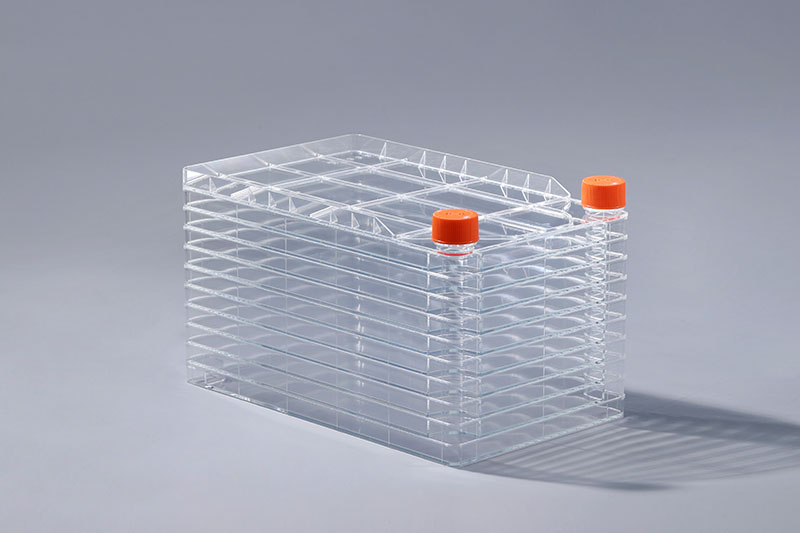ir daudzslāņu šūnu kultūras patērējams materiāls, ko galvenokārt izmanto rūpnieciskajā masveida ražošanā, laboratorijas darbībās un liela mēroga šūnu kultūrā, un tā ir ideāla izvēle pielipušām šūnām. Izvēloties šāda veida palīgmateriālus, mēs pievērsīsim uzmanību galvenajam faktoram, proti, virsmas TC apstrādei, kāpēc tai ir jāveic šī īpašā apstrāde?Šūnas var iedalīt divos veidos: adherent šūnas un suspensijas šūnas saskaņā ar dažādām augšanas metodēm. Suspensijas šūnas nav jāpievieno atbalstam, lai tās augtu, un tās var augt suspensijā barotnē. Pielipušajām šūnām ir jābūt augšanas virsmai, pie kuras tās var piestiprināties, lai augtu, un tikai hidrofils ciets interfeiss var ļaut šūnām pievienoties.cell factory
Šūnu rūpnīca galvenokārt tiek izmantota pielipušo šūnu kultivēšanai, ko apstrādā ar injekcijas formēšanu. caurspīdīga polistirola (PS) izejvielas. Kā polimēru materiālam PS ir laba izturība un plastiskums, un tam nav toksiskuma, un tas ir kļuvis par vēlamo materiālu vienreizlietojamiem šūnu kultūras palīgmateriāliem. Tomēr PS virsma ir hidrofoba, kas pati par sevi neveicina pielipušo šūnu augšanu. Lai uzlabotu šūnu adhēzijas veiktspēju, ir jāveic virsmas modifikācijas apstrāde un hidrofilu grupu ieviešana, lai šūnas varētu labāk augt.
Rezumējot, TC apstrādes mērķis uz šūnu rūpnīcas virsmas ir pielāgoties pielipušo šūnu augšana. Suspensijas šūnu kultūrai izmantotajiem palīgmateriāliem nav obligāti nepieciešami īpaši apstrādāti trauki, bet palīgmateriāli pēc virsmas TC apstrādes parasti ir piemēroti arī suspensijas šūnu kultūrai.
In summary, the purpose of TC treatment on the cell factory surface is to adapt to the growth of adherent cells. The consumables used for suspension cell culture do not necessarily require such specially treated vessels, but the consumables after surface TC treatment are generally also suitable for the culture of suspension cells.
The FAI climbed 5.9 percent year-on-year in the first 11 months of 2018, quickening from the 5.7-percent growth in Jan-Oct, the National Bureau of Statistics (NBS) said Friday in an online statement.
The key indicator of investment, dubbed a major growth driver, hit the bottom in August and has since started to rebound steadily.
In the face of emerging economic challenges home and abroad, China has stepped up efforts to stabilize investment, in particular rolling out measures to motivate private investors and channel funds into infrastructure.
Friday's data showed private investment, accounting for more than 60 percent of the total FAI, expanded by a brisk 8.7 percent.
NBS spokesperson Mao Shengyong said funds into weak economic links registered rapid increases as investment in environmental protection and agriculture jumped 42 percent and 12.5 percent respectively, much faster than the average.
In breakdown, investment in high-tech and equipment manufacturing remained vigorous with 16.1-percent and 11.6-percent increases respectively in the first 11 months. Infrastructure investment gained 3.7 percent, staying flat. Investment in property development rose 9.7 percent, also unchanged.
 English
English



















































